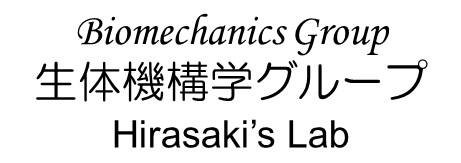����s��C�����i�D�i2015�j�D�e�i�K�U���̃u���L�G�[�V�����C�̈�̉Ȋw 65: 491-495.
|
|
����s��D�i2014�j�D���W�u���s�̗쒷�ފ�Ձv�ɊāC�o�C�I���J�j�Y���w��C38, 168.
|
|
����s��i2012�j�D�T���̕��s����q�g�̒������s�̋N���Ɛi����T��C���s��w�쒷�ތ������ҁw�V�E�쒷�ފw�̂����߁x�C�ۑP�Cpp 19-35�D
|
|
����s��D�T���̕������i2011�j�D���s��w�O���[�o��COE�u�����̑��l���Ɛi�������̂��߂̋��_�`���v�ҁw�����������̂Â�D��A��T���x�Cpp 121-127�D
|
|
����s��C�F�q���Y�i2011�j�D���ꕔ�̋ؔz�u�Ƒ��ꈳ����݂��쒷�ނ̑��̋@�\���CAnthropological Science (Japanese Series) 119, 25-26, 2011�D
|
|
����s��D�i2011�j�D�T���̍��i�A���s�A�]. Anthropological Science (Japanese Series) 119(2): 138�D
119, 25-26, 2011�D
|
|
����s��C�T���̍��i�A���s�A�]�i2011�j�D���{�l�ފw��i���l�ޕ��ȉ�j���[�X���^�[�C25: 4-5.
|
|
����s��i2011�j�D�u���͕��z�V�[�g��p���ăP�[�^�C�������͓���̉�͂̎��݂�v�C�l�ޓ��Ԋw��ҁw���Ԍ����̕��@�x�Cpp 319-322.
|
| 
|
����s��C�F�q���Y�i2011�j�D�u���K�ɂ��n�C�q�[�����s�̕ω��v�C�l�ޓ��Ԋw��ҁw���Ԍ����̕��@�x�Cpp 165-168�D
|
| 
|
����s��C�����i�D�i2009�j�D�����̐i���ƕ��s�C���n�r���e�[�V�����E�G���W�j�A�����O 24: 112-115�D
|
| 
|
���쏲�O, ����s��, �F�q���Y�D�i2008�j�D�]�̕\���^����݂�����̐i��, �] 21 11: 23-29.
|
| 
|
����s��D�i2008�j�D�O��n�ƃo�C�I���J�j�Y���C�o�C�I���J�j�Y���w� 32: 29-30.
|
| 
|
����s��D�i2007�j�D�u���͕��z�Z���T�[��p�����P�[�^�C�������͓����͂̎��݁v�CIn: ���o�C���w��� ���o�C��2007 �����_���W�Cpp 109-114.
|

| 
|
����s��A�����^�l�A���������D�i2006�j�D�j�z���U���̓��s�P������ �`�L�l�}�e�B�N�X�Ƒ������z����݂ā`�C�d�q���ʐM�w��Z�p������ 106 (330): 29-32.
|

| 
|
����s��D(2004)�D�]�i���̐l�ފw�@�|�o�������|�D����w��w�@�l�ԉȊw�����ȋI�v 30: 35-46.
|

| 
|
�F�q���Y�A����ǕF�A����s��D(2004)�D�u�쒷�ރ��R���[�V�����̎����I�����@�|����w��w�@�l�ԉȊw�����Ȑl�Ԑ��Ԋw��������20�N�v�D�����^�l�A���������ҁw���R�l�ފw�����T�x�A�����ɁApp 1-8.
|
|
����s��D(2004)�D�T���̃��R���[�V�����ׂ�D�o�C�I���J�j�Y���w� 28: 2-7.
|

| 
|
����s��D�i2003�j�D�u�}�E���g�T�C�i�C��ȑ�w�_�o�����w�������ł̂Q�N�ԁv�A���{�l�ފw��L�l�V�I���W�[���ȉ�Newsletter 22: 17-20.
|
|
����s��i2003�j�D�쒷�ނ̕��t�@�\�@�|���]�n�Ɣ��K�ǂ��猩�ā|�D��48��v���}�[�e�X������L�^�Cpp 17-22.
|
|
����s��D(2003)�D�ؓo��^���ƒ������s�̐i���D����w��w�@�l�ԉȊw�����ȋI�v 29: 127-143.
|

| 
|
�F�q���Y�A����ǕF�A����s��D(2002)�D�u�������ˋ̋@�\�`�Ԋw�I�����@�|���̎p������Ɋ֘A���ā|�v�D�ؑ��^�ҁw���s�̐i���ƘV���x�A�Ă�����Dp. 71-88.
|
|
����s��D(2000)�D���s���̎���������ێ����铪���^���Ɗዅ�^���D����w��w�@�l�ԉȊw�����ȋI�v 26: 177-193.
|

| 
|
Yamamoto K, Mamoto Y, Imai T, Hirasaki E, Kubo T. (2000). Studies on locomotor patterns in subjects with vestibular dysfunction using 3d analysis video system. In: Equilibrium Research, Clinical Equilibriometry and Modern Treatment (Claussen CF, Haid CT, Hofferberth B. eds.), Amsterdam: Elsevier, pp 261-268.
|
|
Moore S, Hirasaki E, Imai T, Cohen B, Raphan T. (2000). Rotation axes during active head and trunk movements. In: Duysens, J., Smits-Engelsman, B.C.M., Kingma, H. (eds.). Control of Posture and Gait (Proceedings of Symposium of the International Society for Postural and Gait Research), pp 211-214.
|
|
Hirasaki E, Kumakura H, Matano S. (1999). A preliminary analysis of foot movements in Hylobates lar, Ateles geoffroyi and Macaca fuscata during locomotion on arboreal and terrestrial substrates. In: Okada M. editor. Arboreal Locomotor Adaptation in Primates and Its Relevance to Human Evolution, pp 67-69.
|
|
����s��D(1999)�D�u���s��͂̌����v�D�z�q���O�ҁw�ߊO�ȁE�������A�R���s���[�^�V�X�e���ɂ�鐮�`�O�Ȏ��Â̐i���x���W�J���r���[�ЁDp. 128-135.
|
|
����s��A�v�ە��D(1998)�D���s�̎O������́D�\�����ďC�A�������h�E���c�����ҁw�_�o���Ȋw�x�A���F���Dp. 139-151.
|
|
����s��D (1995)�D�������s�O�i�K���f���Ƃ��Ă̐����ؓo����F���̌���ƓW�]�D�l�ފw�S�� 52: 43-57.
|

|
����s��D�i1995�j�D�u���ۊw�p���������̕ɂ����āv�A�쒷�ތ��� 11: 38.
|
|

 = PDF available by request (email)
= PDF available by request (email) = PDF available by request (email)
= PDF available by request (email) = PDF available by request (email)
= PDF available by request (email)